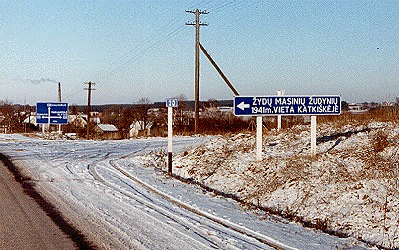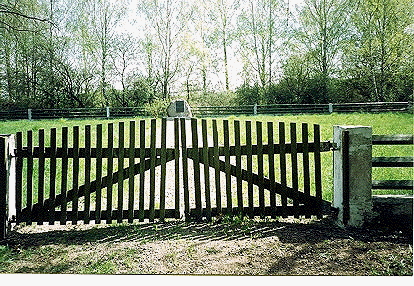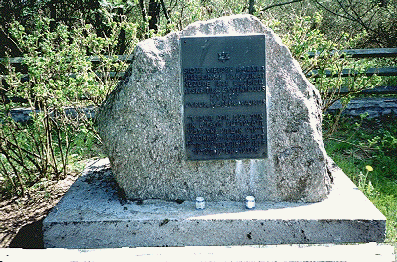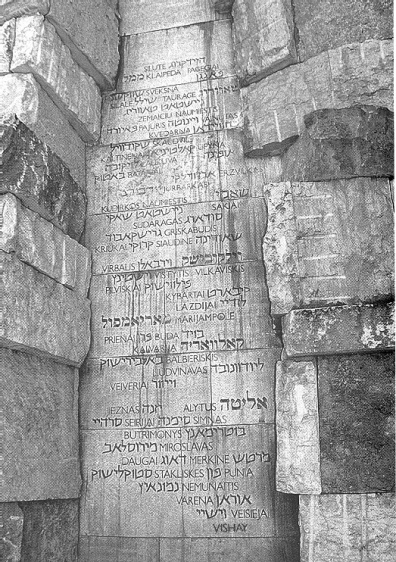

Written by Joseph Rosin (rosin@netvision.net.il).
English edited by Sarah and Mordechai Kopfstein.
Section 3: During World War II and Afterwards
World War II started with the German invasion of Poland on the 1st of September 1939, and its consequences for Lithuanian Jews in general and Lazdey Jews in particular were felt several months later.
In agreement with the Ribbentrop-Molotov treaty on the division of occupied Poland, the Russians occupied the Suvalk region, but after delineation of exact borders between Russia and Germany the Suvalk region fell into German hands. The retreating Russians allowed anyone who wanted to join them to move into their occupied territory, and indeed many young people left the area together with the Russians. The Germans drove the remaining Jews out of their homes in Suvalk and its vicinity, robbed them of their possessions, then directed them to the Lithuanian border, where they were left in dire poverty. The Lithuanians did not allow them to enter Lithuania and the Germans did not allow them to return. Thus they stayed in this swampy area in cold and rain for several weeks, until Jewish youths from the border villages smuggled them into Lithuania by various routes, with much risk to themselves. Altogether about 2,400 refugees passed through the border or infiltrated on their own, and were then dispersed in the "Suvalkia" region including Lazdey where 150 of them were accommodated.
In June 1940 Lithuania was annexed to the Soviet Union and became a Soviet Republic. Following new rules, the majority of the shops belonging to the Jews of Lazdey were nationalized and commissars were appointed to manage them. Also several Jewish houses whose area was more than 220 meters were nationalized and their owners were forced to leave them. All the Zionist parties and youth organizations were disbanded, several of the activists were detained (the local Betar commander Dzivak and Adv. Bergson) and Hebrew educational institutions were closed. A part of the Jews started to intertwine into the new rule institutions. At the October celebrations in 1940 an amateur troupe ("Artistic Brigade") from Vishey performed in Lazdey the play "Bar Kokhva" of Goldfaden with the accompaniment of a local Jazz band.
Supply of goods decreased and, as a result, prices soared. The middle class, mostly Jewish, bore most of the brunt, and the standard of living dropped gradually. At the beginning of June 5 Jewish families whose enterprises were nationalized were exiled deep into Russia (among them Prusak, Titevsky, Gurvitz).
The tragic fate of the Jewish community of Lazdey during the Nazi rule is told further by Rivkah Gershtein Mikhnovsky and her husband Ze'ev Mikhnovsky and by Gedalyah Cohen. (Their story was translated into English by Benjamin Ronn).
"The night before the war between Germany and Russia commenced, the inhabitants of Lazdey were occupied in digging defense trenches. At approximately 3:00 a.m. on June 21, 1941, they noticed red flares that were sent from across the border. Immediately thereafter, a heavy bombardment into Soviet Russian territory began. German bombs also fell in the center of Lazdey and the houses caught on fire, which spread and consumed most of the Jewish homes.
The German army entered Lazdey on Sunday, June 22 at 10:00 a.m. Terror spread throughout the residents. Thousands fled. Only about forty Jews managed to escape with the Soviets by jumping onto their trucks. The rest escaped to the nearby villages where they hoped to find shelter with the farmers. Most of the farmers did not provide shelter for the Jews, did not allow them into their homes, and even denied them a drink of water. The Jews were often received with shouts of "Go back to Stalin, your father!'.
During their escape, bomb fragments injured several of the Jews and some were killed.
On Monday morning, the entire surrounding area calmed down. The German Army had moved forward and the city no longer was on the front. Many of the Jews returned to Lazdey only to be attacked by the local Lithuanians. Noach Kadushin, a leather worker, was badly beaten, and two Jews were forced to dig a grave for him and to bury him alive.
On the same day the Jews fled Lazdey, they were joined by other Jews who were still roaming around the countryside, and they all moved toward Serei, which was approximately 5 kilometers away. Serei, however, was also burned to the ground, and there was no room for the wanderers. The Jews of Lazdey continued to roam in the fields near Lazdey until Shabbath, when the Nazis gave an order that all the Jews of Lazdey should return to Lazdey.
On Monday, June 23, 1941, a meeting of 30 members of the Lithuanian intelligentsia took place in Lazdey. They elected a committee which would manage the affairs of the region. They also declared their thanks and appreciation to the German army and Adolf Hitler. On Wednesday, June 25th, the committee decided to place the Jews in two wooden shacks. The shacks were originally erected by the Russians. In effect, the Jews only had one and a half shacks because the wives and children of Russian officers occupied half of one of them.
Many of the Jews were arrested by the Lithuanians and accused of being of Communists. They arrested young men, almost children, claiming that they were members of the "Komsomol" (Young Communist League). Many were arrested without being accused of anything. If a Lithuanian had any grievances or against any of the Jews, he now obtained his revenge. Many of the people who were arrested were Zionist Revisionists and old people as well. All the people who were arrested were moved to Mariampol and were murdered there.
The remaining Jews were condemned to hard labor. They were given the task of clearing up the ruins of the bombed-out houses and many other jobs that would shame them. Those who had land were given permission to live in their own barns and work in their own fields.
One day a German and a fellow named Zarembo, who was from Lazdey but originally of Polish origin, came to the shacks and took out the Rabbi of Lazdey, Rabbi Ya'akov Arye HaKohen Gershtein, and started beating him with riding whips. When the members of his family came out to see what was happening to their father, they were also beaten. The Rabbi was later put on a truck and driven away.
The Jews went to the local priest to ask for his help because Rabbi Gershtein served as the local Rabbi for over twenty years and had an excellent reputation among Jews and non-Jews alike. The priest excused himself by saying that he was not able to help the Rabbi at all. The chief of police was also not willing to help. Later in the day, those who were returning from one of the work gangs related that they saw the Rabbi being brought to where they were working. He was forced to carry heavy sacks of cement. While everyone else was allowed to return as usual on the wagons, the Germans mocked him and said, 'Let him walk". Shortly thereafter, the Rabbi returned to the shacks.
The Jews were only allowed to walk in the gutters and were not allowed to step or walk on the sidewalks. Upon seeing a German soldier, a Jew was compelled to remove his hat and bow his head with his face facing the soldier. Only when the German left was he allowed to return his hat and straighten up.
Almost from the first day of the Nazi occupation the Jewish residents were the focus of torture and robbery. Both the Germans and the Lithuanians demanded watches, jewelry, silver, gold, and other valuables under threats of bodily harm. Policemen and Lithuanian thugs would often beat people mercilessly. Every Sunday after the Lithuanians left their church, they would take the Jewish males from the shacks, bring them to the marker square, and would torture them with so called "physical exercise." They would force them to roll in the dirt, hit each other, and perform other stunts to the amusement and pleasure of the spectators. Thugs would attack the Jews and hit them mercilessly. The Lithuanian guards would demand from the Jews that they turn over their money, gold, and valuables to them. They would force them to strip and would search their clothes. A significant amount of property was stolen from the Jews in those days.
Rumors about murder and extermination of the Jews in the surrounding areas were reaching Lazdey. In mid-September, the rumor was heard that the of Jews of nearby Leipun were murdered. On September 15, the Jews of so Lazdey were ordered to move to the army barracks in the estate of Katkishok (Katkiske) about a kilometer and a half away. They were promised that a ghetto would be set up for them where they would spend the duration of the war. The Jews of an Lazdey already knew that the Jews in other cities of Lithuania were almost totally eliminated; therefore, they treated this proposed move with great of suspicion. Some of them went out to explore Katkishok and to find out if there were any pits dug for a mass burial site. The lack of pits eased their to concern only a little.
A few hours later, Jews from the nearby communities of Vishey, Koptcheveh, and Rudamin as well as Jews from the nearby villages were brought to L.azdey. All of them were destined for Katkishok. This fact calmed the Jews somewhat. They thought that the Germans were serious in creating a to ghetto. That very same day, all the Jews were moved to Katkishok. They were laced in the army barracks by family, and the entire area was surrounded by barbed wire and armed Lithuanian guards. Daily work groups were used for work outside the compound.
Initially, they gave each person 200 grams of unsalted bread and 300 grams of potatoes. Gradually the rations were cut down, and an epidemic of dysentery broke out. People suffered and starved. Some snuck out and ran to nearby villages where they exchanged personal belonging for food or begged for food. A certain relief occurred when some of the local farmers were allowed to engage Jews as workers on their farms, provided that they would return them to the ghetto at night. Those who ate at the farms would give up their share of the food in the ghetto so that others could benefit from it.
The internal arrangements of the work schedule were conducted by the Jewish managed Arbeits Amt (Work Office). A special committee to manage all the affairs of the ghetto was created from representatives from all of the communities. The pharmacist Astromsky from Koptcheveh was their leader. He did not do a thing without consulting with Rabbi Gershtein of Lazdei. A Jewish police force was organized in the ghetto but had very little authority.
Every gentile was able to do whatever he pleased. Hardly a day passed without some torture or criminal act. For example, a Lithuanian policeman once took a liking to the boots of Yehoshua Vilensky from Rudamin. He called him over, shot him dead, and took his boots.
One day the ghetto was shocked by the secret news Sheina Idovitz and Golda Katorovsky related upon their return from work on Monday, October 27th. Every day they were taken to the town to work for the German commander. That day, they heard a conversation between the commandant of Mariampol who screamed at the commandant of Lazdei what a terrible shame it was that his Jews were still alive. The commandant from Lazdei apologized and explained that he needed the Jews who were doing necessary work and many of the essential crafts. The commandant from Mariampol screamed again, "You have to fulfill your task or otherwise you will be sent to the front" Whereby the commandant of Lazdei replied, "I am a soldier and a man of war, and you won't scare me with this kind of a threat.'
The mood in the ghetto was electrified instantaneously. The sounds of the wings of death shook the people and scared them in anticipation of the following day. That night some people escaped from the ghetto and went looking for a hideout with the farmers or in the fields. A few days later, however, when no special events had occurred, everything returned to normal. They expected that the commandant would continue to protect the Jews under his control. By the end of October, most of the Jews throughout Lithuania were already murdered, while those of Lazdei were among some of the very few left alive.
On Thursday, October 30, 1941, the ghetto was sealed and nobody was taken out to work. They were able to see that the murderous Lithuanians were walking in the distance with spades in their hands. Upon asking the chief of the police as to the meaning of this scene, he responded nonchalantly, "They are going to dig pits for you. This will take a few days and that is exactly the length of time left for you to be alive." After that explanation, many attempted to run away even though the place was well guarded by armed guards. The following morning, escapees were returned to the camp, some wounded and some murdered, and the chief of police came to calm the Jews. He told them that running away does not make sense since everywhere the German foot is placed the Jew gets wiped off the face of the earth. He went on to say that a Jew can never find a hiding place from the bullet that is marked for him, and that very soon the end will come for all the Jews wherever they on might be.
The Lithuanians sealed all the windows and doors to the barracks with planks and metal bars, and the Jews stayed locked up without water or food. Despite all their efforts, 180 people managed to escape from the barracks in the first two nights.
On Monday, November 3, 1941 (the 13th of Mar-Che~shvan, 5702), the Jews were taken naked from the barracks to the dug out pits about 300 meters away from the barracks and about 300 meters west of the forest. About 1600 souls were shot to death there. Not one person managed to escape. Although the Germans gave the orders for the 'operation,' they participated only as the observers at the scene of the crime. The actual executioners were Lithuanians. A gang of apparently experienced murderers from Mariampol also participated in the executions. This gang seemed experienced because of their actions and later, that they refused the Germans' offer to photograph them in order to "memorialize" their actions. Only in December of 1941 did the first signs of the German's retreat and defeat appear when the Germans were forced back into winter defensive positions. As mentioned earlier, many escaped before the slaughter. Some were badly wounded, caught, and brought back to the ghetto. On the day of the slaughter, they were dragged with the other sick and helpless to the pits. Many of the escapees were killed by the farmers. After a while, the Lithuanians stopped murdering the caught escapees and incarcerated them instead. When the number of the caught escapees reached 35, they took them to the mass graves and murdered them there.
From the entire 180 who escaped, only 6 survived the war: Rivka (Gershtein) Mikhnovsky and her husband Ze'ev Mikhnovsky, Dov Zef, Miriam Kuleisky and her sisters Gita and Bat-Sheva Koifman-all from Lazdey; Khmilavsky from Vishay; Gedalia Cohen from Rudamin.
In 1944 and 1945, the Soviets regained Lithuania, Estonia, and Latvia, and they were again made Soviet republics. Seven kilometers from the Polish border, Lazdey was made a center of a Soviet administrative district in the Lithuanian Soviet Socialist Republic. Suvalk remained in the Bialystok province of Poland.
After the war, Rivka and her husband Ze'ev Mikhnovsky returned to their native town of Lazdey. There they had a child there, the last known Jew to be born in Lazdey. Shortly afterwards they moved to Eretz-Yisrael and no Jews are known to have lived in Lazdey since. Lazdey's population in 1959 was 3109.
During the war, the tombstones in Lazdey's Jewish cemetery were overturned. Apparently, it was not demolished and built over as the Soviets did to numerous other Jewish cemeteries.

Picture taken by Ruth ben David 1994 (from
Pilitovsky family)
The entrance gate
of the Jewish cemetery, the only scraps
On the 13th of Mar-Cheshvan every year, natives of Lazdey living in Israel assemble in the Tel Aviv area for a memorial service in memory of the day of the annihilation of the Jews of Lazdey. After the memorial service, there is usually a friendly get-together. The well-known lawyer and native of Lazdey, Avraham (Golub) Tory, often speaks at these meetings. Each year, however, the attendance decreases as fewer natives of Lazdey remain alive".
The names of the Lithuanians who sheltered them are saved at the archives of Yad-Vashem.
After the war the survivors of the above mentioned towns erected a monument on the mass graves at Katkiske. In 1991 a new monument was erected with the inscription in Lithuanian and Yiddish: At this place the Hitlerist murderers with their local helpers murdered on the 3.11.1941 1,535 Jews from the Lazdey district, men, women and children.

Picture supplied by Ruth ben David 1994
(from Pilitovsky family)
Sign on
the road: The place of the mass murder of the Jews in 1941 at
Katkiske

Picture taken by Ruth ben David 1994 (from
Pilitovsky family)
Entrance gate
to the mass graves and the monument

Picture taken by Ruth be David 1994 (from
Pilitovsky family)
The Monument

The tablet on the Monument

The wall with the name of Lazdey in "The Valley of the Communities" in Yad Vashem, Jerusalem
According to the survey of Jewish cemeteries in Lithuania performed in 1990, a Jewish cemetery was found at the Lazdey district in the village Bukta.
The Small Lithuanian Encyclopedia, Vilnius 1966-1971 (Lithuanian).
The Lithuanians Encyclopedia, Boston 1953-1965 (Lithuanian).
Lite, New-York 1951, Volume 1 (Yiddish).
Yahaduth Lita, (Hebrew) Tel-Aviv, Volumes 1-4
Yad-Vashem Archives ,Koniuchovsky Collection 0-71, Files 131,132
Central Zionist Archives: 55/1788; 55/1701; 13/15/131; Z-4/2548.
JIVO, NY, Collection of the Jewish Communities in Lithuania, Files 517-540, pages 22596-23618
HaMeilitz (St. Petersburg) (Hebrew): 30.7.1879, 16.11.1879, 29.3.1881, 14.7.1884, 9.7.1886, 2.7.1888, 11.12.1893.
Cohen Berl,. Shtet, Shtetlach un Dorfishe Yishuvim in Lite biz 1918 (Towns, Small Towns and Rural Settlements in Lithuania till 1918) (Yiddish) New-York 1992.
From the Beginning to the End - The Book of the History of "HaShomer HaTzair" in Lithuania (Hebrew), Tel-Aviv 1986.
Folksblat, Kovno (Yiddish): 23.6.1935, 24.6.1935, 25.7.1939, 17.11.1940.
Di Yiddishe Shtime (The Yiddish Voice) Kovno (Yiddish): 28.12.1920, 22.8.1922, 12.2.1928, 9.8.1932, 22.5.1935.
Der Yiddisher Kooperator Kovno (Yiddish): Nr.2-3, 1922
Masines Zudynes Lietuvoje (Mass Murder in Lithuania) vol. 1-2, Vilnius 1941-1944 (Lithuanian).
Pinkas haKehiloth. Lita (Encyclopedia of Jewish Settlements in Lithuania) (Hebrew), Editor: Dov Levin, Assistant editor: Yosef Rosin, Yad Vashem. Jerusalem 1996.
Dzuku Zinios (Lithuanian) Nr.55, 22.7.1992
The Book of Sorrow, (Hebrew, Yiddish, English, Lithuanian), Vilnius 1997.
Copyright ©2000, Yosef Rosin
[Previous Section] [Next Section] [Return to History Table of Contents] [Return to Lazdei Home Page]